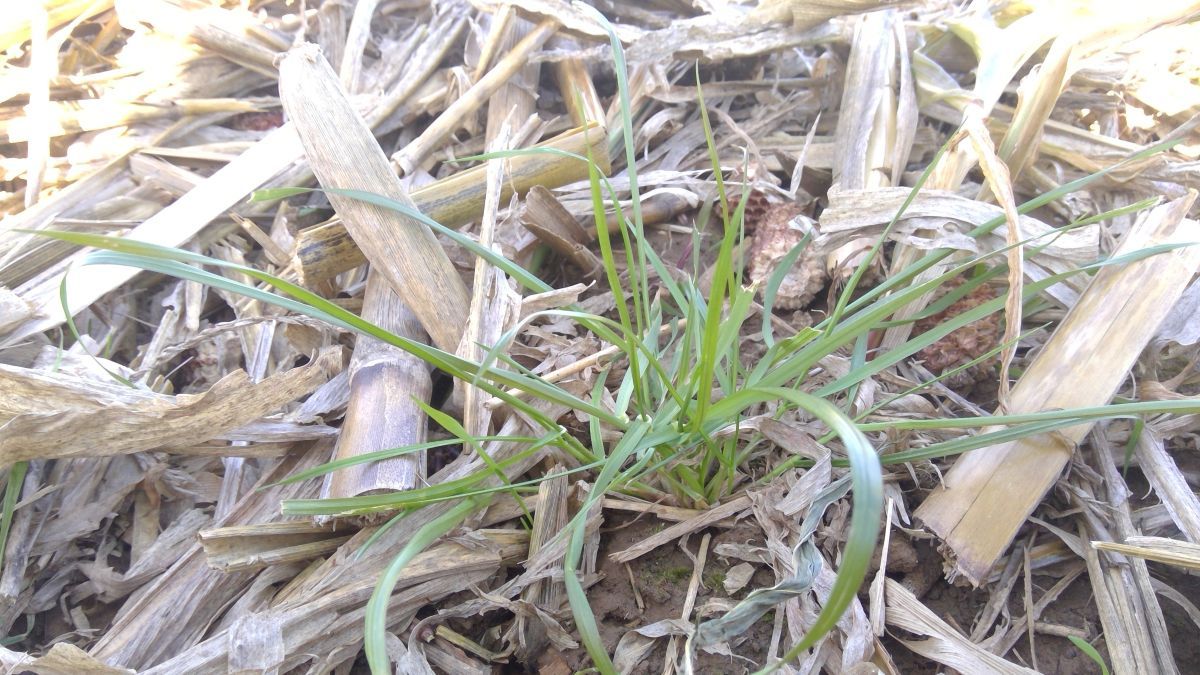Set the Stage for a Successful Growing Season with a Strong Burndown
Set the Stage for a Successful Growing Season with a Strong Burndown

After a miserably wet February with several spells of unusually cold temps, March is finally bringing spring weather. Along with spring weather comes winter annual weed growth and burndown applications will begin in earnest in the very near future. As the sprayers head to the field, here are a few quick reminders and tips to help start the growing season with a successful herbicide burndown.
Italian Ryegrass Demands Special Attention
Italian Ryegrass (aka annual ryegrass) is an increasing issue on Kentucky corn and soybean acres with failed burndowns increasing every year across the state.
Annual ryegrass is one of the first weeds to green up in late winter and is already taking advantage of the increasing temperatures. One essential key for a successful annual ryegrass burndown is making applications within the window of the three conditions outlined in Figure 1.
Figure 1. The optimal window for Italian (annual) ryegrass burndown occurs when all three of these parameters occur at the same time.
Unfortunately, capturing this window of the correct growth stage, air temperatures, and soil conditions can be almost impossible in most Kentucky springs. With the understanding that we may not be able to capture this magical window on every acre, we must focus on maximizing our burndown applications in other ways. We have found based on our research that the following keys are essential to maximizing the burndown of Italian ryegrass (See Figure 2 for further data from our 2024 spring burndown trial):
Use at least 1.5lb ae/a glyphosate (40 fl oz Roundup PowerMax 3)
- This has been shown In UK weed science research numerous times and is the single biggest mistake I find when a failure occurs. Ryegrass burndown applications are NOT the place to cut rates when looking to cut inputs
- There is a handy chart on page 17 of AGR-6 where you can find the rate of your specific glyphosate product that is equivalent to 1.5 lb ae/a.
The addition of 1 fl oz Sharpen (or 15 fl oz Verdict) to 1.5 lb ae glyphosate results in the consistently greatest ryegrass control in our research.
- Our research in 2024 found preliminary results that the inclusion of MSO as an adjuvant in this tank mix may be the leading contributor to the increased consistency in ryegrass control. We are actively conducting a second year of research to confirm these findings.
Avoid tank mixing atrazine or metribuzin with glyphosate and as these products will antagonize glyphosate activity on ryegrass.
The best non-glyphosate mixture is Gramoxone plus atrazine or metribuzin plus 2,4-D or dicamba.
- Paraquat (Gramoxone) and atrazine or metribuzin are synergistic and increase control as compared to each of the components applied alone. The addition of 2,4-D or dicamba is optional for those fields where troublesome broadleaves like marestail (horseweed) exist.
- These tank mixtures work best on small ryegrass and under warm sunny conditions. A follow up application to capture any regrowth should be planned.
Avoid the use of Select Max (clethodim) or other group 1 herbicides
- The group 1 herbicides (clethodim, quizalofop, sethoxadim, etc) work very slowly in comparison to other systemic herbicides when the weather is warm. When you spray these products in the spring when temperatures are cool, especially overnight, this only exacerbates the slow activity and ryegrass almost always escapes application of the group 1 herbicides.
- We have heard of a few applicators using low rates of Select Max (2 to 3 fl oz/a) with glyphosate and have observed increased control over glyphosate alone. We always discourage the use of reduced rates of herbicides, as this is a known pathway to herbicide resistance. Additionally, I suspect that the increased activity has less to do with active ingredient (clethodim) and more to do with the EC or ‘oily’ formulation that is acting as an adjuvant similar to the MSO mentioned above.
Pay Attention to the Wind
March is bringing a welcome increase in temperatures that will allow for successful spring applications, unfortunately the warmer temperatures are typically accompanied with high winds which are not favorable for spray applications. Each year I receive numerous calls from specialty crop growers, homeowners, and fellow grain crop farmers with complaints of drift from spring burndown applications. Typically, we are including either growth regulators (2,4-D or dicamba) and/or contact herbicides such as saflufenacil in our burndowns which can cause significant off-target injury at very low rates. As the warm temperatures and calendar give us all spring fever and the urge “to do something in the field” be aware of wind conditions and avoid the costly mistake of drifting onto a neighbor.
Adjuvants
Make sure you understand what adjuvants are needed to assure your herbicide applications are effective. Adjuvants are often needed to ensure the product can effectively find its way into the weed and to its target site of action. The exclusion of an adjuvant such as MSO from a Sharpen application can be the difference in a successful and a failed burndown. You can either refer to the herbicide label or AGR-6 for recommended or required adjuvants for the products you plan to apply. Additionally, if you would like more information on the importance of adjuvants in herbicide applications, refer to this CPN Publication: Adjuvants with Herbicides: When and Why They are Needed.
Carriers
Last year, we received a few questions about the use of liquid nitrogen as a carrier for spring burndown applications. While the inclusion of a small amount of nitrogen (such as ammonium sulfate) can be beneficial in getting herbicides into plants, larger amounts such as liquid N as a carrier may have the opposite effect. Liquid nitrogen can cause rapid plant tissue necrosis and antagonize the movement of a systemic herbicide to its target site of action allowing weeds to survive the herbicide application.
We would recommend to use water as your burndown carrier for the most effective herbicide applications. Although all water is not created equally, and we must be aware of the properties of the water we use for herbicide applications. As we start a new growing season it may be wise to go ahead and check your water sources’ pH and hardness. Adjustment of water hardness and pH can be critical for successful herbicide applications throughout the season. In the challenging conditions of spring burndowns having a quality water carrier can go a long way.
Citation: Legleiter, T., 2025. Set the Stage for a Successful Growing Season with a Strong Burndown. Kentucky Field Crops News, Vol 1, Issue 3. University of Kentucky, March 14, 2025.
 Dr. Travis Legleiter, UK Extension Weed Specialist
Dr. Travis Legleiter, UK Extension Weed Specialist
(859) 562-1323
travis.legleiter@uky.edu
